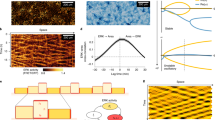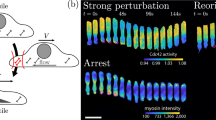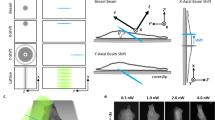Abstract
Molecular gradients are important for various biological processes including the polarization of tissues and cells during embryogenesis and chemotaxis. Investigations of these phenomena require control over the chemical microenvironment of cells. We present a technique to set up molecular concentration patterns that are chemically, spatially and temporally flexible. Our strategy uses optically manipulated microsources, which steadily release molecules. Our technique enables the control of molecular concentrations over length scales down to about 1 μm and timescales from fractions of a second to an hour. We demonstrate this technique by manipulating the motility of single human neutrophils. We induced directed cell polarization and migration with microsources loaded with the chemoattractant formyl-methionine-leucine-phenylalanine. Furthermore, we triggered highly localized retraction of lamellipodia and redirection of polarization and migration with microsources releasing cytochalasin D, an inhibitor of actin polymerization.
This is a preview of subscription content, access via your institution
Access options
Subscribe to this journal
Receive 12 print issues and online access
$259.00 per year
only $21.58 per issue
Buy this article
- Purchase on Springer Link
- Instant access to full article PDF
Prices may be subject to local taxes which are calculated during checkout





Similar content being viewed by others
References
Gurdon, J.B. & Bourillot, P.Y. Morphogen gradient interpretation. Nature 413, 797–803 (2001).
Meinhardt, H. Models of biological pattern formation: from elementary steps to the organization of embryonic axes. Curr. Top. Dev. Biol. 81, 1–63 (2008).
Wadhams, G.H. & Armitage, J.P. Making sense of it all: bacterial chemotaxis. Nat. Rev. Mol. Cell Biol. 5, 1024–1037 (2004).
Kay, R.R., Langridge, P., Traynor, D. & Hoeller, O. Changing directions in the study of chemotaxis. Nat. Rev. Mol. Cell Biol. 9, 455–463 (2008).
Van Haastert, P.J.M. & Devreotes, P.N. Chemotaxis: signalling the way forward. Nat. Rev. Mol. Cell Biol. 5, 626–634 (2004).
Cyster, J.G. Chemokines and cell migration in secondary lymphoid organs. Science 286, 2098–2102 (1999).
Weiner, O.D. Regulation of cell polarity during eukaryotic chemotaxis: the chemotactic compass. Curr. Opin. Cell Biol. 14, 196–202 (2002).
Parent, C.A. & Devreotes, P.N. A cell's sense of direction. Science 284, 765–770 (1999).
Iglesias, P.A. & Levchenko, A. Modeling the cell's guidance system. Sci. STKE 2002, re12 (2002).
Skupsky, R., Losert, W. & Nossal, R.J. Distinguishing modes of eukaryotic gradient sensing. Biophys. J. 89, 2806–2823 (2005).
Herzmark, P. et al. Bound attractant at the leading vs. the trailing edge determines chemotactic prowess. Proc. Natl. Acad. Sci. USA 104, 13349–13354 (2007).
Beta, C., Wyatt, D., Rappel, W.J. & Bodenschatz, E. Flow photolysis for spatiotemporal stimulation of single cells. Anal. Chem. 79, 3940–3944 (2007).
Samadani, A., Mettetal, J. & van Oudenaarden, A. Cellular asymmetry and individuality in directional sensing. Proc. Natl. Acad. Sci. USA 103, 11549–11554 (2006).
Sun, B.Y. & Chiu, D.T. Synthesis, loading, and application of individual nanocapsules for probing single-cell signaling. Langmuir 20, 4614–4620 (2004).
Dufresne, E.R. & Grier, D.G. Optical tweezer arrays and optical substrates created with diffractive optics. Rev. Sci. Instrum. 69, 1974–1977 (1998).
Dufresne, E.R., Spalding, G.C., Dearing, M.T., Sheets, S.A. & Grier, D.G. Computer-generated holographic optical tweezer arrays. Rev. Sci. Instrum. 72, 1810–1816 (2001).
Mejean, C.O., Schaefer, A.W., Millman, E.A., Forscher, P. & Dufresne, E.R. Multiplexed force measurements on live cells with holographic optical tweezers. Opt. Express 17, 6209–6217 (2009).
Cooper, J.A. Effects of cytochalasin and phalloidin on actin. J. Cell Biol. 105, 1473–1478 (1987).
Urbanik, E. & Ware, B.R. Actin filament capping and cleaving activity of cytochalasin-B, cytochalasin-D, cytochalasin-E and cytochalasin-H. Arch. Biochem. Biophys. 269, 181–187 (1989).
Fahmy, T.M., Samstein, R.M., Harness, C.C. & Saltzman, W.M. Surface modification of biodegradable polyesters with fatty acid conjugates for improved drug targeting. Biomaterials 26, 5727–5736 (2005).
Servant, G. et al. Polarization of chemoattractant receptor signaling during neutrophil chemotaxis. Science 287, 1037–1040 (2000).
Zigmond, S.H. Ability of polymorphonuclear leukocytes to orient in gradients of chemotactic factors. J. Cell Biol. 75, 606–616 (1977).
Ebert, S., Travis, K., Lincoln, B. & Guck, J. Fluorescence ratio thermometry in a microfluidic dual-beam laser trap. Opt. Express 15, 15493–15499 (2007).
Steenblock, E.R. & Fahmy, T.M. A comprehensive platform for ex vivo T-cell expansion based on biodegradable polymeric artificial antigen-presenting cells. Mol. Ther. 16, 765–772 (2008).
Vasir, J.K. & Labhasetwar, V. Biodegradable nanoparticles for cytosolic delivery of therapeutics. Adv. Drug Deliv. Rev. 59, 718–728 (2007).
Cohen, S., Yoshioka, T., Lucarelli, M., Hwang, L.H. & Langer, R. Controlled delivery systems for proteins based on poly(lactic/glycolic acid) microspheres. Pharm. Res. 8, 713–720 (1991).
Jiang, W.L., Gupta, R.K., Deshpande, M.C. & Schwendeman, S.P. Biodegradable poly(lactic-co-glycolic acid) microparticles for injectable delivery of vaccine antigens. Adv. Drug Deliv. Rev. 57, 391–410 (2005).
Dinsmore, A.D. et al. Colloidosomes: selectively permeable capsules composed of colloidal particles. Science 298, 1006–1009 (2002).
Slowing, I.I., Trewyn, B.G., Giri, S. & Lin, V.S.Y. Mesoporous silica nanoparticles for drug delivery and biosensing applications. Adv. Funct. Mater. 17, 1225–1236 (2007).
Carroll, N.J. et al. Droplet-based microfluidics for emulsion and solvent evaporation synthesis of monodisperse mesoporous silica microspheres. Langmuir 24, 658–661 (2008).
Servant, G., Weiner, O.D., Neptune, E.R., Sedat, J.W. & Bourne, H.R. Dynamics of a chemoattractant receptor in living neutrophils during chemotaxis. Mol. Biol. Cell 10, 1163–1178 (1999).
Acknowledgements
We thank S. Dandekar, A. Houk, A. Millius and S. Wilson for help with cell culturing and sample preparation, A. Schaefer for helpful discussions, and M. Elimelech and W. Mitch for use of equipment. This work was supported by a fellowship (BMBF-LPD 9901/8-162) from the German Academy of Sciences Leopoldina to H.K., a US National Institutes of Health grant (1U54-RR0222332) and US National Science Foundation grants (CBET-0619674 and DBI–0619674) to E.R.D., a US National Institutes of Health grant (RO1-GM084040) to O.D.W and a US National Science Foundation CAREER grant (CBET-0747577) to T.M.F.
Author information
Authors and Affiliations
Contributions
H.K. and E.R.D. designed and performed the research, analyzed data and wrote the paper. J.G.P., J.D.F., S.S.W. and O.D.W. performed research and analyzed data. C.O.M. and Y.Z. performed research. J.P. and T.M.F. designed research and contributed new reagents and analytic tools. D.W. designed research.
Corresponding authors
Supplementary information
Supplementary Text and Figures
Supplementary Figures 1–10 and Supplementary Notes 1–7 (PDF 8345 kb)
Supplementary Video 1
A single optically manipulated bead which is loaded with chemoattractant is able to induce directed polarization and migration of a neutrophil. An individual PLGA particle loaded with fMLP is optically micromanipulated and moved close to the membrane of a HL-60 cell. The cell starts to polarize and migrate in the direction of the particle. The particle is moved in a counter clockwise way around the cell and the cell is changing its polarization and migration direction in response to the altered particle position. Scale bar, 10 μm. (MOV 355 kb)
Supplementary Video 2
A chemoattractant-loaded particle induces cell motility and change of the direction of migration of a neutrophil. An individual PLGA particle loaded with fMLP is optically micromanipulated and moved close to the membrane of a HL-60 cell. The cell starts to polarize and migrate at an angle of about 45° relative to the gradient direction as defined by the bead position. After about 200 seconds, the cell changes its direction of motion and migrates in the direction of the particle. During this motion, the cell forms a stable lamellipodium at its leading edge. Scale bar, 10 μm. (MOV 883 kb)
Supplementary Video 3
Bipolar stimulation with chemoattractant induces formation and broadening of a lamellipodium. Upon positioning of the fMLP-loaded beads close to a HL-60 cell, the cell forms a lamellipodium in the direction of the beads. As the cell advances, it broadens its lamellipodium approaching both beads. Ultimately, the lamellipodium reaches its maximal size, and the cell orients towards the lower left bead. Scale bar, 10 μm. (MOV 940 kb)
Supplementary Video 4
A control particle does not stimulate a cell response. An individual optically manipulated plain PLGA particle (no fMLP encapsulated) is used to try to stimulate a HL-60 cell. The cell does protrude and retract in varying directions, but it does not protrude or migrate in the direction of the particle. Scale bar, 10 μm. (MOV 574 kb)
Supplementary Video 5
A control particle does not stimulate a cell response. An individual optically manipulated plain PLGA particle (no fMLP encapsulated) is used to try to stimulate a HL-60 cell. The cell does protrude and retract in varying directions, but it does not protrude or migrate in the direction of the particle. Scale bar, 10 μm. (MOV 614 kb)
Supplementary Video 6
Optically manipulated microsources of cytochalasin D induce highly localized retraction in the center of a lamellipodium. Two beads releasing the actin polymerization inhibitor cytochalasin D are positioned close to the center of the lamellipodium of a HL-60 cell. The lamellipodium starts to retract in a small region around the beads yielding a lamellipodium that is split into two parts. Finally, one of the two lamellipodia retracts and only one remains. Scale bar, 10 μm. (MOV 1605 kb)
Supplementary Video 7
Migrating cell squeezes between two optically manipulated microsources of cytochalasin D. The two beads are placed in front of a migrating HL-60 cell. Then, the bead-to-bead distance is increased to about 20 μm. As the cell migrates towards the two particles, the lamellipodium starts to retract on the two sides closest the beads while the central part of the leading edge continues to extend. Finally, the cell rounds up and retracts its leading edge. Scale bar, 10 μm. (MOV 1826 kb)
Supplementary Video 8
Cell response to time-varying bipolar stimulus of cytochalasin D. A HL-60 cell stops its migration and retracts its lamellipodium in response to two cytochalasin-releasing beads which are placed in the direction of cell migration. Then, the two beads are positioned on two opposing ends of the cell in the direction of cell polarization. Subsequently, the cell re-polarizes in a direction perpendicular to the axis defined by the beads. Scale bar, 10 μm. (MOV 945 kb)
Rights and permissions
About this article
Cite this article
Kress, H., Park, JG., Mejean, C. et al. Cell stimulation with optically manipulated microsources. Nat Methods 6, 905–909 (2009). https://doi.org/10.1038/nmeth.1400
Received:
Accepted:
Published:
Issue Date:
DOI: https://doi.org/10.1038/nmeth.1400
This article is cited by
-
Porous microwells for geometry-selective, large-scale microparticle arrays
Nature Materials (2017)
-
Optical micromanipulation of nanoparticles and cells inside living zebrafish
Nature Communications (2016)
-
Light-driven micro-tool equipped with a syringe function
Light: Science & Applications (2016)
-
Generation of tunable and pulsatile concentration gradients via microfluidic network
Microfluidics and Nanofluidics (2015)
-
Optically-controlled platforms for transfection and single- and sub-cellular surgery
Biophysical Reviews (2015)



